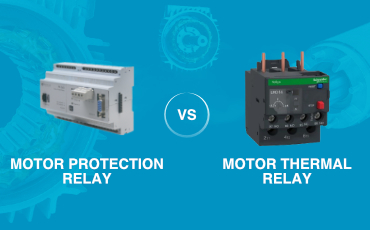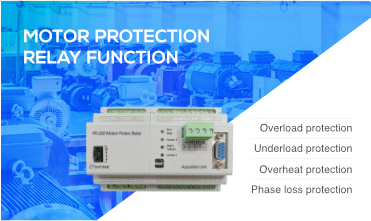
Motor Thermal Relay vs Motor protection relay – Which is better
By bluejay | Company News
The motor thermal relay and intelligent motor protection relay are equipped with motor overload protection, motor stall protection, and motor phase loss protection. However, there are some differences between them. What are the advantages of motor protection relays over motor thermal relays? This article will explore the differences between motor protection relays and thermal protection relays in motor protection.
Motor Protection Relay Definition
The motor protection relay, also called a motor protector, is a specialized safety device mounted on the motor control board. It’s designed to safeguard the motor and circuit by disconnecting the power supply or reducing motor current whenever the motor experiences issues like overcurrent, undercurrent, phase failure, stalling, overheating, or overload. This helps prevent motor damage and ensures the circuit’s safety.

Motor Thermal Relay Definition
A motor thermal relay is an electrical device that protects motors from overload. It monitors the heat generated by the motor’s current. When the current gets too high and the motor’s temperature rises too much, the motor thermal relay automatically shuts off the power to prevent motor damage.

What's the difference between motor thermal relay and motor protection relay?
Motor Thermal Relay vs Motor protection relay in comprehensive Protection
Compared to motor thermal relays, motor protection relays offer more comprehensive protection. While a motor thermal relay only provides overload, stall, and phase loss protection, an intelligent motor protector features a wider range of safeguards. These include overcurrent (including stall), three-phase current imbalance, grounding/leakage, start timeout, underload, Under voltage, overvoltage, under power, temperature, external fault, phase sequence, anti-sway, and voltage loss restart functions. This broader protection effectively safeguards both the motor and the circuit. A motor thermal protection relay can only prevent the motor from burning out, whereas a motor protection relay can also prevent overloading.
Motor Thermal Relay vs Motor Protection Relay in Overload Protection
A motor thermal relay can only be used to trip (or shut off) the power supply, not to generate an alarm. In contrast, an intelligent motor protection relay can perform tripping and alarm functions.
Motor Thermal Relay vs Motor Protection Relay in Current-Carrying Capacity
As a bimetallic strip, a thermal relay must be able to handle a high current load. Being a mutual inductor, an intelligent motor protective relay doesn’t need to directly withstand large currents, making it better suited for high-current applications.
Motor Thermal Relay vs Motor Protection Relay in Contact Independence
It’s challenging for motor thermal relays to produce independent contacts. Intelligent Motor protective relay can easily output independent contacts, providing more versatility in control and monitoring.
Motor Thermal Relay vs Motor Protection Relay in Other Features
Intelligent motor protective relays offer additional features compared to motor thermal relays, including:
- Control Functions: For tasks like motor starting and stopping.
- Measurement Functions: Measuring three-phase current, voltage, power, power factor, electric energy, frequency, thermal capacity, current imbalance rate, leakage current value, and more.
- Fault Recording: Recording information such as current running time, current parking time, cumulative running time, starting current, starting time, number of operations, input and output status, 8 fault records, and running status indication.
- 4-20mA Output: For analog signal communication.
- Communication Function: For connecting to other devices or systems.
- State Quantity Detection: Monitoring various parameters and conditions.
- Faster response: The motor protector can quickly cut off the power supply when the motor fails to prevent the fault from expanding, while the thermal relay needs to wait until the motor temperature rises before cutting off the power supply, and the response speed is slow.
- Better adjustability: The motor protector can automatically adjust the current when the motor is overloaded to prevent the motor from overheating, while the thermal relay needs to adjust the current manually.
- More convenient to use: The motor protector is generally installed on the motor control board, which can be easily adjusted and maintained, while the thermal relay needs to be adjusted and maintained from outside the control cabinet.
Motor Thermal Relay vs Motor Protection Relay in Cost-Effectiveness
Intelligent energy-saving motor protection relays are more cost-effective than motor thermal relays. The motor thermal protection relays require additional accessories to achieve motor protection, control, monitoring, and measurement. These accessories include:
Thermal relay protectors
I/O modules for monitoring
Switch-on and switch-off indicator lights, ammeters, ammeter transformers, and DCS system transmitters for measurement
Voltage relay for power supply loss monitoring
Intermediate relay for transmitting motor faults to the DCS system
In contrast, the digital motor protection relay can perform all these functions without requiring additional equipment. This makes the intelligent electric motor protective relay a more cost-effective solution.

Overall, motor protection relays are more versatile and have a broader range of applications. They’re well-suited for industries that heavily rely on motors, including petroleum, chemical, smelting, steel, desulfurization and denitrification, power plants, and sewage treatment. Blue Jay offers high-quality motor protection relays that combine protection, control, measurement, metering, power quality analysis, fault recording analysis, and communication features.
Related articles
Tags
Company News
The motor thermal relay and intelligent motor protection relay are equipped with motor overload protection, motor stall protection, and motor phase loss protection. However, there are some differences between them. What are the advantages of motor protection relays over motor thermal relays? This article will explore the differences between motor protection relays and thermal protection relays in motor protection.
Motor Protection Relay Definition
The motor protection relay, also called a motor protector, is a specialized safety device mounted on the motor control board. It’s designed to safeguard the motor and circuit by disconnecting the power supply or reducing motor current whenever the motor experiences issues like overcurrent, undercurrent, phase failure, stalling, overheating, or overload. This helps prevent motor damage and ensures the circuit’s safety.

Motor Thermal Relay Definition
A motor thermal relay is an electrical device that protects motors from overload. It monitors the heat generated by the motor’s current. When the current gets too high and the motor’s temperature rises too much, the motor thermal relay automatically shuts off the power to prevent motor damage.

What's the difference between motor thermal relay and motor protection relay?
Motor Thermal Relay vs Motor protection relay in comprehensive Protection
Compared to motor thermal relays, motor protection relays offer more comprehensive protection. While a motor thermal relay only provides overload, stall, and phase loss protection, an intelligent motor protector features a wider range of safeguards. These include overcurrent (including stall), three-phase current imbalance, grounding/leakage, start timeout, underload, Under voltage, overvoltage, under power, temperature, external fault, phase sequence, anti-sway, and voltage loss restart functions. This broader protection effectively safeguards both the motor and the circuit. A motor thermal protection relay can only prevent the motor from burning out, whereas a motor protection relay can also prevent overloading.
Motor Thermal Relay vs Motor Protection Relay in Overload Protection
A motor thermal relay can only be used to trip (or shut off) the power supply, not to generate an alarm. In contrast, an intelligent motor protection relay can perform tripping and alarm functions.
Motor Thermal Relay vs Motor Protection Relay in Current-Carrying Capacity
As a bimetallic strip, a thermal relay must be able to handle a high current load. Being a mutual inductor, an intelligent motor protective relay doesn’t need to directly withstand large currents, making it better suited for high-current applications.
Motor Thermal Relay vs Motor Protection Relay in Contact Independence
It’s challenging for motor thermal relays to produce independent contacts. Intelligent Motor protective relay can easily output independent contacts, providing more versatility in control and monitoring.
Motor Thermal Relay vs Motor Protection Relay in Other Features
Intelligent motor protective relays offer additional features compared to motor thermal relays, including:
- Control Functions: For tasks like motor starting and stopping.
- Measurement Functions: Measuring three-phase current, voltage, power, power factor, electric energy, frequency, thermal capacity, current imbalance rate, leakage current value, and more.
- Fault Recording: Recording information such as current running time, current parking time, cumulative running time, starting current, starting time, number of operations, input and output status, 8 fault records, and running status indication.
- 4-20mA Output: For analog signal communication.
- Communication Function: For connecting to other devices or systems.
- State Quantity Detection: Monitoring various parameters and conditions.
- Faster response: The motor protector can quickly cut off the power supply when the motor fails to prevent the fault from expanding, while the thermal relay needs to wait until the motor temperature rises before cutting off the power supply, and the response speed is slow.
- Better adjustability: The motor protector can automatically adjust the current when the motor is overloaded to prevent the motor from overheating, while the thermal relay needs to adjust the current manually.
- More convenient to use: The motor protector is generally installed on the motor control board, which can be easily adjusted and maintained, while the thermal relay needs to be adjusted and maintained from outside the control cabinet.
Motor Thermal Relay vs Motor Protection Relay in Cost-Effectiveness
Intelligent energy-saving motor protection relays are more cost-effective than motor thermal relays. The motor thermal protection relays require additional accessories to achieve motor protection, control, monitoring, and measurement. These accessories include:
Thermal relay protectors
I/O modules for monitoring
Switch-on and switch-off indicator lights, ammeters, ammeter transformers, and DCS system transmitters for measurement
Voltage relay for power supply loss monitoring
Intermediate relay for transmitting motor faults to the DCS system
In contrast, the digital motor protection relay can perform all these functions without requiring additional equipment. This makes the intelligent electric motor protective relay a more cost-effective solution.

Overall, motor protection relays are more versatile and have a broader range of applications. They’re well-suited for industries that heavily rely on motors, including petroleum, chemical, smelting, steel, desulfurization and denitrification, power plants, and sewage treatment. Blue Jay offers high-quality motor protection relays that combine protection, control, measurement, metering, power quality analysis, fault recording analysis, and communication features.
Related articles







